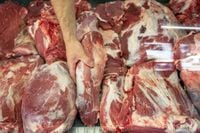Global meat markets are experiencing a dramatic transformation in 2025, with beef prices soaring to historic highs and rippling effects being felt across agribusiness, consumer markets, and investment portfolios. This upheaval is the result of a complex web of supply constraints, shifting trade policies, climate pressures, and surging demand—particularly from the United States and China. As the traditional livestock industry grapples with these challenges, the rapid ascent of meat alternatives is reshaping the future of protein consumption and agricultural investment.
According to the United Nations Food and Agriculture Organization (FAO), global meat prices reached a new record in August 2025, surpassing the previous high set just a month earlier. The FAO's meat price index, a closely watched benchmark, reflects the relentless upward momentum in meat markets, largely fueled by robust American and Chinese appetites for beef. This surge has not gone unnoticed by consumers: in the United Kingdom, consumer prices for beef and veal were nearly 25% higher in July 2025 compared to the previous year, worsening inflation headaches in households already grappling with rising food costs.
At the heart of this price rally lies a combination of dwindling global cattle supplies and major shifts in international trade dynamics. Australian slaughter cattle prices have skyrocketed by more than 50% since July 2025, as reported by Elders, a leading agricultural services provider. The catalyst? The non-renewal of U.S. beef export licenses to China, which has redirected a wave of Chinese demand toward Australian producers. As a result, Australian exports to China have leapt by 51%, while shipments to the U.S. have grown by 27% over the same period. Meanwhile, new U.S. tariffs on Brazilian beef have further cemented Australia’s role as a critical supplier to the world’s largest beef importers.
These trade shifts have left the U.S. domestic market in a bind. Domestic cattle slaughter in the United States continues to lag behind 2024 levels, tightening supply and pushing retail beef prices to multi-year highs. The squeeze is being felt not just by American consumers but by businesses up and down the supply chain. According to a recent market update, agribusinesses are feeling the heat as they scramble to adapt to this new, more volatile normal.
But it’s not just economics and geopolitics driving change. Climate-related disruptions are compounding the supply crunch. As noted in a recent Springer article, beef production remains a significant contributor to greenhouse gas emissions and biodiversity loss, particularly in high-income countries. The global meat supply has nearly doubled since the 1960s, but the sector now faces mounting scrutiny over its environmental footprint. This has spurred a growing movement toward “less but better” meat consumption, with pasture-raised ruminants and regenerative agriculture gaining traction as more sustainable alternatives.
For investors and agribusinesses, resilience is the watchword. U.S. agriculture investment funds are projected to grow by 8% annually to $20 billion in assets by 2025, with a strong focus on sustainable practices such as regenerative farming and water conservation. These strategies not only align with environmental, social, and governance (ESG) mandates but also enhance long-term returns. Agricultural land investment funds now routinely integrate climate resilience metrics into their risk management frameworks, according to recent industry analysis.
Technological innovation is another pillar of adaptation. The adoption of AI-driven farm management and precision agriculture tools is helping to reduce input costs and boost efficiency—a crucial advantage in a market where margins are under pressure. Companies that have embraced generative AI for targeted innovation in crop yields or livestock health are outperforming their peers, even in these turbulent times. However, the sector still faces significant challenges, including rural talent shortages and the need for strategic consolidation to scale up sustainable practices, as highlighted in a Boston Consulting Group report.
Meanwhile, the meat alternatives sector is emerging as a formidable counterweight to traditional livestock production. The global plant-based meat market is valued at $10.2 billion in 2025 and is projected to grow at a staggering 17.9% compound annual growth rate, reaching $45 billion by 2034. Fermentation-based proteins, which accounted for over half of the $18 billion in cumulative investments in 2024, are leading the charge in alternative protein innovation. In the first half of 2025 alone, alternative protein startups raised $364 million, underscoring investor confidence in the sector’s potential.
Innovation is not limited to plant-based burgers. Companies like Juicy Marbles and vEEF are pushing the boundaries with high-protein vegan lamb and carbon-neutral plant-based products, respectively. Cultivated meat firms such as Mosa Meat and Vow are also making headlines: Mosa Meat, for example, managed to raise €1.5 million through crowdfunding in the wake of a post-2023 funding slump. Hybrid products that blend plant-based proteins with cultivated or fermentation-derived components are gaining popularity for their improved taste and nutritional profiles.
India, with its rich biodiversity and strong vegetarian culture, is positioned as a potential global leader in sustainable meat alternatives. In the U.S., plant-based products now command 11% of the market share, signaling a significant shift in consumer preferences. Strategic partnerships and continued product innovation are expected to accelerate adoption further in the coming years.
Nevertheless, the path ahead is not without obstacles. High production costs, regulatory hurdles, and consumer price sensitivity remain significant barriers for meat alternatives. For traditional agribusinesses, the drive toward greater sustainability presents existential risks. The environmental impact of beef could prompt policy interventions, such as carbon taxes or subsidies for alternative proteins, which would further alter the competitive landscape.
Investors and companies are hedging their bets by diversifying across both sectors. Industry giants like Cargill and Tyson Foods are expanding into plant-based lines while simultaneously optimizing their supply chains for climate resilience. Startups such as Impossible Foods and Redefine Meat are capitalizing on the surge in investment, raising hundreds of millions to scale their operations and technology platforms.
The global meat industry stands at a crossroads. The convergence of tightening cattle supplies, climate pressures, and evolving consumer preferences is rewriting the rules for producers, investors, and consumers alike. Those who can adapt—by embracing sustainability, investing in technology, and diversifying into new protein sources—will be best positioned to thrive in this rapidly changing landscape.
As the world’s appetite for protein evolves, the winners will be those who can balance resilience and innovation, ensuring a secure and sustainable food future for generations to come.

